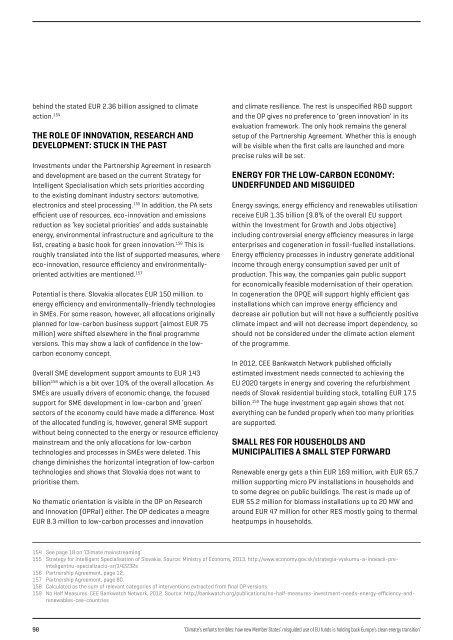ENFANTS TERRIBLES
enfants-terribles
enfants-terribles
You also want an ePaper? Increase the reach of your titles
YUMPU automatically turns print PDFs into web optimized ePapers that Google loves.
ehind the stated EUR 2.36 billion assigned to climate<br />
action. 154<br />
THE ROLE OF INNOVATION, RESEARCH AND<br />
DEVELOPMENT: STUCK IN THE PAST<br />
Investments under the Partnership Agreement in research<br />
and development are based on the current Strategy for<br />
Intelligent Specialisation which sets priorities according<br />
to the existing dominant industry sectors: automotive,<br />
electronics and steel processing. 155 In addition, the PA sets<br />
efficient use of resources, eco-innovation and emissions<br />
reduction as ‘key societal priorities’ and adds sustainable<br />
energy, environmental infrastructure and agriculture to the<br />
list, creating a basic hook for green innovation. 156 This is<br />
roughly translated into the list of supported measures, where<br />
eco-innovation, resource efficiency and environmentallyoriented<br />
activities are mentioned. 157<br />
Potential is there. Slovakia allocates EUR 150 million. to<br />
energy efficiency and environmentally-friendly technologies<br />
in SMEs. For some reason, however, all allocations originally<br />
planned for low-carbon business support (almost EUR 75<br />
million) were shifted elsewhere in the final programme<br />
versions. This may show a lack of confidence in the lowcarbon<br />
economy concept.<br />
Overall SME development support amounts to EUR 143<br />
billion 158 which is a bit over 10% of the overall allocation. As<br />
SMEs are usually drivers of economic change, the focused<br />
support for SME development in low-carbon and ‘green’<br />
sectors of the economy could have made a difference. Most<br />
of the allocated funding is, however, general SME support<br />
without being connected to the energy or resource efficiency<br />
mainstream and the only allocations for low-carbon<br />
technologies and processes in SMEs were deleted. This<br />
change diminishes the horizontal integration of low-carbon<br />
technologies and shows that Slovakia does not want to<br />
prioritise them.<br />
No thematic orientation is visible in the OP on Research<br />
and Innovation (OPRaI) either. The OP dedicates a meagre<br />
EUR 8.3 million to low-carbon processes and innovation<br />
and climate resilience. The rest is unspecified R&D support<br />
and the OP gives no preference to ‘green innovation’ in its<br />
evaluation framework. The only hook remains the general<br />
setup of the Partnership Agreement. Whether this is enough<br />
will be visible when the first calls are launched and more<br />
precise rules will be set.<br />
ENERGY FOR THE LOW-CARBON ECONOMY:<br />
UNDERFUNDED AND MISGUIDED<br />
Energy savings, energy efficiency and renewables utilisation<br />
receive EUR 1.35 billion (9.8% of the overall EU support<br />
within the Investment for Growth and Jobs objective)<br />
including controversial energy efficiency measures in large<br />
enterprises and cogeneration in fossil-fuelled installations.<br />
Energy efficiency processes in industry generate additional<br />
income through energy consumption saved per unit of<br />
production. This way, the companies gain public support<br />
for economically feasible modernisation of their operation.<br />
In cogeneration the OPQE will support highly efficient gas<br />
installations which can improve energy efficiency and<br />
decrease air pollution but will not have a sufficiently positive<br />
climate impact and will not decrease import dependency, so<br />
should not be considered under the climate action element<br />
of the programme.<br />
In 2012, CEE Bankwatch Network published officially<br />
estimated investment needs connected to achieving the<br />
EU 2020 targets in energy and covering the refurbishment<br />
needs of Slovak residential building stock, totalling EUR 17.5<br />
billion. 159 The huge investment gap again shows that not<br />
everything can be funded properly when too many priorities<br />
are supported.<br />
SMALL RES FOR HOUSEHOLDS AND<br />
MUNICIPALITIES A SMALL STEP FORWARD<br />
Renewable energy gets a thin EUR 169 million, with EUR 65.7<br />
million supporting micro PV installations in households and<br />
to some degree on public buildings. The rest is made up of<br />
EUR 55.2 million for biomass installations up to 20 MW and<br />
around EUR 47 million for other RES mostly going to thermal<br />
heatpumps in households.<br />
154<br />
155<br />
156<br />
157<br />
158<br />
159<br />
See page 18 on ‘Climate mainstreaming’<br />
Strategy for Intelligent Specialisation of Slovakia. Source: Ministry of Economy, 2013. http://www.economy.gov.sk/strategia-vyskumu-a-inovacii-preinteligentnu-specializaciu-sr/142232s<br />
Partnership Agreement, page 12.<br />
Partnership Agreement, page 80.<br />
Calculated as the sum of relevant categories of interventions extracted from final OP versions.<br />
No Half Measures. CEE Bankwatch Network, 2012. Source: http://bankwatch.org/publications/no-half-measures-investment-needs-energy-efficiency-andrenewables-cee-countries<br />
98<br />
‘Climate’s enfants terribles: how new Member States’ misguided use of EU funds is holding back Europe’s clean energy transition’


